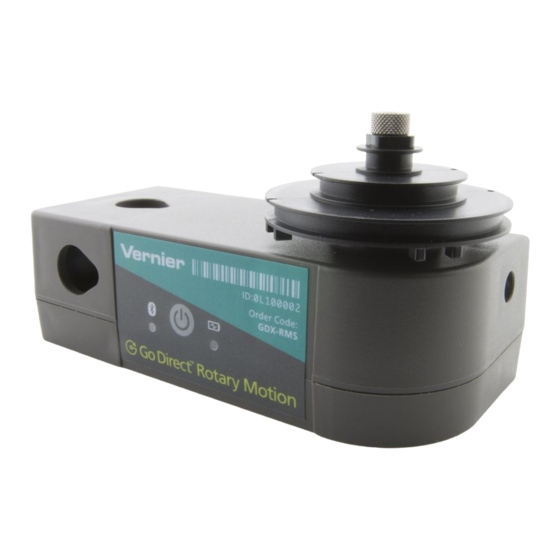
Advertisement
Quick Links
®
Go Direct
Rotary Motion
(Order Code GDX-RMS)
Go Direct Rotary Motion is a bidirectional angle
sensor designed to measure rotational or linear
position, velocity and acceleration. It is used for a variety of applications,
including
Determining rotational inertia
l
Investigating angular motion applications of Newton's second law
l
Investigating conservation of angular momentum
l
Verifying Malus's law
l
Studying the motion a physical pendulum
l
Measuring linear position for experiments such as the inverse square law of
l
light
Note: Vernier products are designed for educational use. Our products are not
designed nor are they recommended for any industrial, medical, or commercial
process such as life support, patient diagnosis, control of a manufacturing
process, or industrial testing of any kind.
What's Included
Go Direct Rotary Motion
l
Micro USB Cable
l
Thumb screw
l
3-step pulley and mounting screw
l
O-ring
l
Compatible Software
See
www.vernier.com/manuals/gdx-rms
Go Direct Rotary Motion.
Assembly
The 3-step pulley can be mounted on the rotating shaft in either of two
orientations: with the wide side of the pulley near the sensor body, or with the
narrow side of the pulley near the sensor body. The easiest way to insert the
3-step pulley on the Rotary Motion Sensor shaft is hold the shaft to prevent
rotation as you turn the pulley to align the key to the slot. The O-ring can be
slipped over the outer pulley to increase friction when the pulley is in contact
with a surface.
The thumb screw can be threaded into the back of the sensor allowing the
Rotary Motion Sensor to be attached to a ring stand.
for a list of software compatible with the
The sensor also has a set of accessory mounting holes that allow it to connect to
existing accessories such as the Polarizer Analyzer (PAK-OEK) and the Rotary
Motion Motor Kit (MK-RMV).
Getting Started
Please see the following link for platform-specific connection information:
www.vernier.com/start/gdx-rms
Bluetooth Connection
1. Install Vernier Graphical
Analysis™ on your computer,
Chromebook™, or mobile device. If
®
using LabQuest
, make sure
LabQuest App is up to date. See
www.vernier.com/ga4 for Graphical
Analysis availability or
www.vernier.com/downloads to
update LabQuest App.
2. Charge your sensor for at least
2 hours before first use.
3. Turn on your sensor by pressing the
power button once. The Bluetooth
LED will blink red.
4. Launch Graphical Analysis or turn
on LabQuest.
5. If using Graphical Analysis, click
or tap Sensor Data Collection. If
using LabQuest, choose Wireless
Device Setup > Go Direct from the
Sensors menu.
6. Select your Go Direct sensor from
the list of Discovered Wireless
Devices. Your sensor's ID is located
near the barcode on the sensor. The
Bluetooth LED will blink green
when it is successfully connected.
7. Click or tap Done. You are now
ready to collect data.
1
USB Connection
1. If using a computer or
Chromebook, install Vernier
Graphical Analysis. If using
LabQuest, make sure LabQuest
App is up to date. See
www.vernier.com/ga4 for Graphical
Analysis availability or
www.vernier.com/downloads to
update LabQuest App.
2. Connect the sensor to the USB
port.
3. Launch Graphical Analysis or turn
®
on LabQuest. You are now ready to
collect data.
4. This is a multi-channel sensor. To
change the channel selections, see
www.vernier.com/start/gdx-rms
Note: This sensor does not work with
the original LabQuest. It works with
LabQuest 2 or LabQuest 3.
Advertisement

Summary of Contents for Vernier Go Direct GDX-RMS
- Page 1 1. Install Vernier Graphical 1. If using a computer or Note: Vernier products are designed for educational use. Our products are not Analysis™ on your computer, Chromebook, install Vernier designed nor are they recommended for any industrial, medical, or commercial Chromebook™, or mobile device.
- Page 2 8. This is a multi-channel sensor. To change the channel selections, see Connected and charging Orange LED next to the battery icon is solid www.vernier.com/start/gdx-rms when the sensor is connected to Graphical Ana- lysis via USB and the unit is charging. LED next Charging the Sensor to Bluetooth icon is off.
- Page 3 ~24 hours If you have watched followed the troubleshooting steps and are still having (single full trouble with your Go Direct Rotary Motion, contact Vernier Technical Support charge) at support@vernier.com or call 888-837-6437. Support specialists will work with you to determine if the unit needs to be sent in for repair. At that time, a...
- Page 4 Bluetooth SIG, Inc. and any use of radiated power (e.i.r.p.) is not more than that permitted for successful communication. such marks by Vernier Software & Technology is under license. Other trademarks and trade names are those of RF exposure warning: The equipment complies with RF exposure limits set forth for an uncontrolled environment.
















Need help?
Do you have a question about the Go Direct GDX-RMS and is the answer not in the manual?
Questions and answers